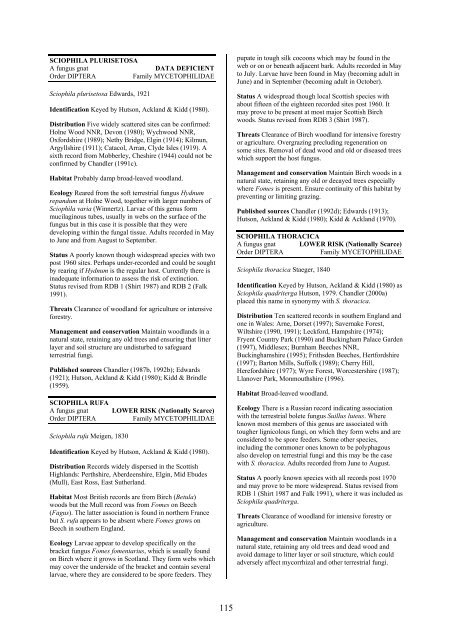Part 2: Nematocera and Aschiza not dealt with by Falk (1991) - JNCC
Part 2: Nematocera and Aschiza not dealt with by Falk (1991) - JNCC
Part 2: Nematocera and Aschiza not dealt with by Falk (1991) - JNCC
You also want an ePaper? Increase the reach of your titles
YUMPU automatically turns print PDFs into web optimized ePapers that Google loves.
SCIOPHILA PLURISETOSA<br />
A fungus gnat<br />
DATA DEFICIENT<br />
Order DIPTERA<br />
Family MYCETOPHILIDAE<br />
Sciophila plurisetosa Edwards, 1921<br />
Identification Keyed <strong>by</strong> Hutson, Ackl<strong>and</strong> & Kidd (1980).<br />
Distribution Five widely scattered sites can be confirmed:<br />
Holne Wood NNR, Devon (1980); Wychwood NNR,<br />
Oxfordshire (1989); Nethy Bridge, Elgin (1914); Kilmun,<br />
Argyllshire (1911); Catacol, Arran, Clyde Isles (1919). A<br />
sixth record from Mobberley, Cheshire (1944) could <strong>not</strong> be<br />
confirmed <strong>by</strong> Ch<strong>and</strong>ler (<strong>1991</strong>c).<br />
Habitat Probably damp broad-leaved woodl<strong>and</strong>.<br />
Ecology Reared from the soft terrestrial fungus Hydnum<br />
rep<strong>and</strong>um at Holne Wood, together <strong>with</strong> larger numbers of<br />
Sciophila varia (Winnertz). Larvae of this genus form<br />
mucilaginous tubes, usually in webs on the surface of the<br />
fungus but in this case it is possible that they were<br />
developing <strong>with</strong>in the fungal tissue. Adults recorded in May<br />
to June <strong>and</strong> from August to September.<br />
Status A poorly known though widespread species <strong>with</strong> two<br />
post 1960 sites. Perhaps under-recorded <strong>and</strong> could be sought<br />
<strong>by</strong> rearing if Hydnum is the regular host. Currently there is<br />
inadequate information to assess the risk of extinction.<br />
Status revised from RDB 1 (Shirt 1987) <strong>and</strong> RDB 2 (<strong>Falk</strong><br />
<strong>1991</strong>).<br />
Threats Clearance of woodl<strong>and</strong> for agriculture or intensive<br />
forestry.<br />
Management <strong>and</strong> conservation Maintain woodl<strong>and</strong>s in a<br />
natural state, retaining any old trees <strong>and</strong> ensuring that litter<br />
layer <strong>and</strong> soil structure are undisturbed to safeguard<br />
terrestrial fungi.<br />
Published sources Ch<strong>and</strong>ler (1987b, 1992b); Edwards<br />
(1921); Hutson, Ackl<strong>and</strong> & Kidd (1980); Kidd & Brindle<br />
(1959).<br />
SCIOPHILA RUFA<br />
A fungus gnat LOWER RISK (Nationally Scarce)<br />
Order DIPTERA<br />
Family MYCETOPHILIDAE<br />
Sciophila rufa Meigen, 1830<br />
Identification Keyed <strong>by</strong> Hutson, Ackl<strong>and</strong> & Kidd (1980).<br />
Distribution Records widely dispersed in the Scottish<br />
Highl<strong>and</strong>s: Perthshire, Aberdeenshire, Elgin, Mid Ebudes<br />
(Mull), East Ross, East Sutherl<strong>and</strong>.<br />
Habitat Most British records are from Birch (Betula)<br />
woods but the Mull record was from Fomes on Beech<br />
(Fagus). The latter association is found in northern France<br />
but S. rufa appears to be absent where Fomes grows on<br />
Beech in southern Engl<strong>and</strong>.<br />
Ecology Larvae appear to develop specifically on the<br />
bracket fungus Fomes fomentarius, which is usually found<br />
on Birch where it grows in Scotl<strong>and</strong>. They form webs which<br />
may cover the underside of the bracket <strong>and</strong> contain several<br />
larvae, where they are considered to be spore feeders. They<br />
pupate in tough silk cocoons which may be found in the<br />
web or on or beneath adjacent bark. Adults recorded in May<br />
to July. Larvae have been found in May (becoming adult in<br />
June) <strong>and</strong> in September (becoming adult in October).<br />
Status A widespread though local Scottish species <strong>with</strong><br />
about fifteen of the eighteen recorded sites post 1960. It<br />
may prove to be present at most major Scottish Birch<br />
woods. Status revised from RDB 3 (Shirt 1987).<br />
Threats Clearance of Birch woodl<strong>and</strong> for intensive forestry<br />
or agriculture. Overgrazing precluding regeneration on<br />
some sites. Removal of dead wood <strong>and</strong> old or diseased trees<br />
which support the host fungus.<br />
Management <strong>and</strong> conservation Maintain Birch woods in a<br />
natural state, retaining any old or decayed trees especially<br />
where Fomes is present. Ensure continuity of this habitat <strong>by</strong><br />
preventing or limiting grazing.<br />
Published sources Ch<strong>and</strong>ler (1992d); Edwards (1913);<br />
Hutson, Ackl<strong>and</strong> & Kidd (1980); Kidd & Ackl<strong>and</strong> (1970).<br />
SCIOPHILA THORACICA<br />
A fungus gnat LOWER RISK (Nationally Scarce)<br />
Order DIPTERA<br />
Family MYCETOPHILIDAE<br />
Sciophila thoracica Staeger, 1840<br />
Identification Keyed <strong>by</strong> Hutson, Ackl<strong>and</strong> & Kidd (1980) as<br />
Sciophila quadriterga Hutson, 1979. Ch<strong>and</strong>ler (2000a)<br />
placed this name in synonymy <strong>with</strong> S. thoracica.<br />
Distribution Ten scattered records in southern Engl<strong>and</strong> <strong>and</strong><br />
one in Wales: Arne, Dorset (1997); Savernake Forest,<br />
Wiltshire (1990, <strong>1991</strong>); Leckford, Hampshire (1974);<br />
Fryent Country Park (1990) <strong>and</strong> Buckingham Palace Garden<br />
(1997), Middlesex; Burnham Beeches NNR,<br />
Buckinghamshire (1995); Frithsden Beeches, Hertfordshire<br />
(1997); Barton Mills, Suffolk (1989); Cherry Hill,<br />
Herefordshire (1977); Wyre Forest, Worcestershire (1987);<br />
Llanover Park, Monmouthshire (1996).<br />
Habitat Broad-leaved woodl<strong>and</strong>.<br />
Ecology There is a Russian record indicating association<br />
<strong>with</strong> the terrestrial bolete fungus Suillus luteus. Where<br />
known most members of this genus are associated <strong>with</strong><br />
tougher lignicolous fungi, on which they form webs <strong>and</strong> are<br />
considered to be spore feeders. Some other species,<br />
including the commoner ones known to be polyphagous<br />
also develop on terrestrial fungi <strong>and</strong> this may be the case<br />
<strong>with</strong> S. thoracica. Adults recorded from June to August.<br />
Status A poorly known species <strong>with</strong> all records post 1970<br />
<strong>and</strong> may prove to be more widespread. Status revised from<br />
RDB 1 (Shirt 1987 <strong>and</strong> <strong>Falk</strong> <strong>1991</strong>), where it was included as<br />
Sciophila quadriterga.<br />
Threats Clearance of woodl<strong>and</strong> for intensive forestry or<br />
agriculture.<br />
Management <strong>and</strong> conservation Maintain woodl<strong>and</strong>s in a<br />
natural state, retaining any old trees <strong>and</strong> dead wood <strong>and</strong><br />
avoid damage to litter layer or soil structure, which could<br />
adversely affect mycorrhizal <strong>and</strong> other terrestrial fungi.<br />
115
















